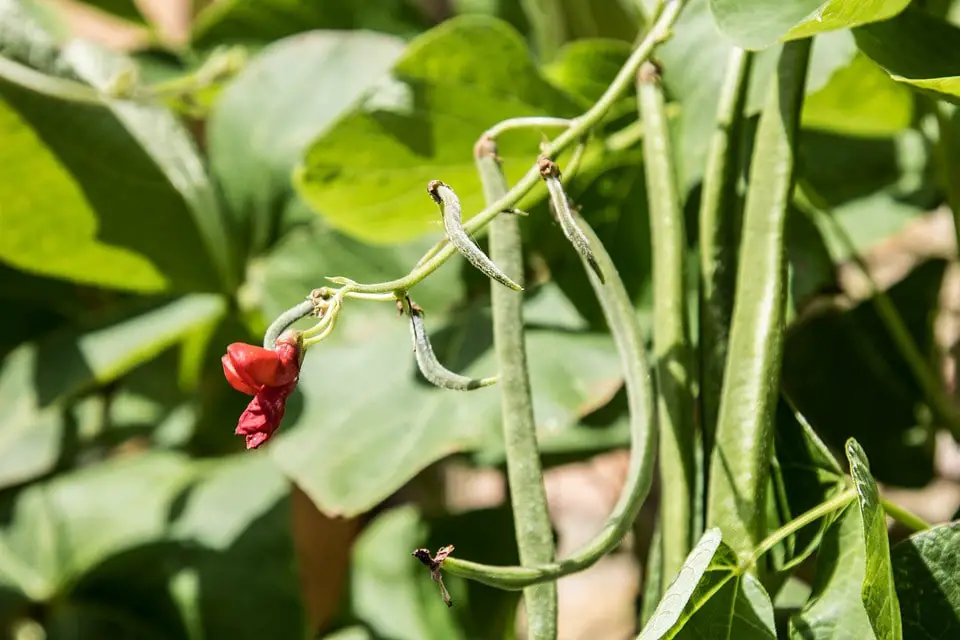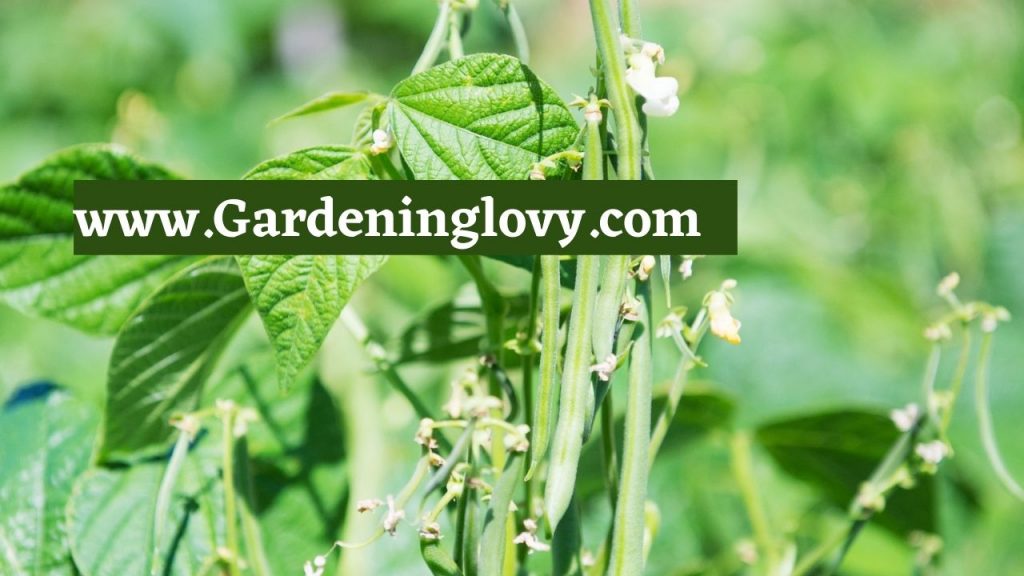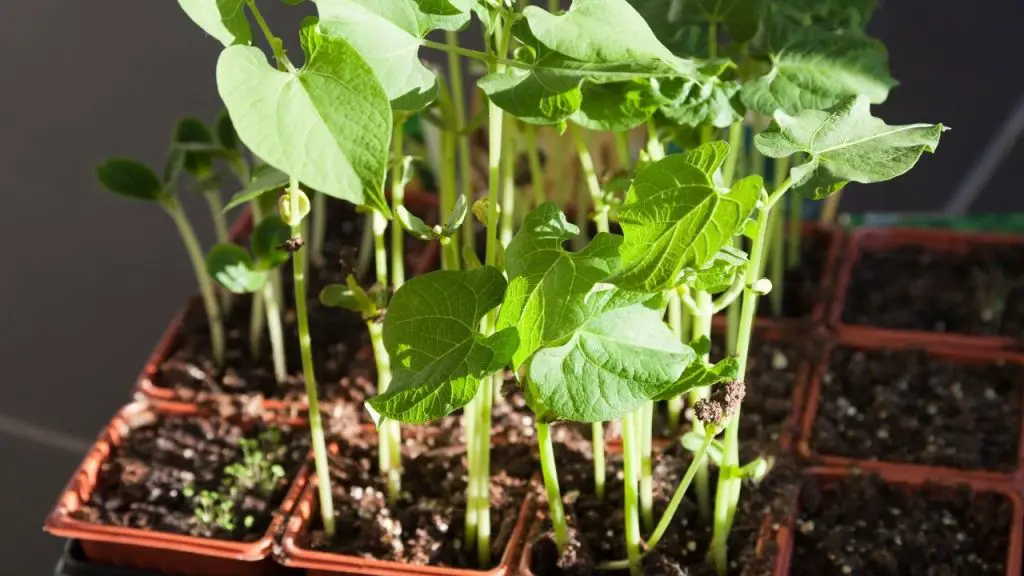I have been growing green beans for quite a time now. what motivated me to start growing beans was my love of green and yellow beans. Green beans till now, remain one of my favorite cultivating and eating vegetables. I cultivate both bush and pole bean varieties, growing them in my garden beds throughout the harvest periods.

In this article, you are going to learn the step-by-step process of how to grow green beans and plant bean seeds, along with below most requested FAQs.
- How to grow green beans indoors
- Best Tips on how to grow pole beans
- How To grow green bean from seeds
- Can we grow long beans in pots
- how long does it take for green beans to grow
- Growing green beans problems
Are Green Beans Easy To Grow?
As most people ask, “ is green bean a vegetable?” Green beans are the favorite of any vegetable gardener because they are both simple and fast to grow, making them the perfect vegetable for even inexperienced gardeners as well. They are extremely bountiful and productive, even in a small space.
Most beans are simply green, but they also come in different colors like purple, red, yellow. The beans are sometimes are called snap or string beans.
What are the Different types of green beans to grow?
The green or snap beans, the yellow, and the yellow-green bean variety are the most widely cultivated beans. The type of bean is also grouped into bush beans and pole beans.
Here are four spectacular green beans to grow:
- The Kentucky Wonder’: a pole bean type that produces 8-inch long pods on 6- to 8-foot (1.8-2.4m) long vines.
- ‘Bountiful’: a bush bean planted for extra early autumn harvests and also for late autumn plantings for harvest before the first winter frost.
- The Bush Blue Lake: bush bean plants type that produces a heavy yield of tasty pods that are soft and crisp.
- ‘Fortex’: also called filet is a bean characterized by dark green, extra slender 7-inch pods.
Also read below interesting gardening tips & tricks.
- Exclusive Green leaf Organic Pest Control [#21] Tips
- Best [11] Siberian Pea Shrub Tree Care & Grow Guide
- How To Harvest Lettuce! So It Keeps Growing – Ultimate Guide With [15 Tips]
- How To Harvest Spinach Crop! So It Keeps Growing- Exclusive [15 Ways]
- How To Grow Brussels Sprouts (16+ Step-By-Step Beginners Pro Guide)
- How To Plant Tomatoes [Quick & Easy 21+ Ways]- Beginners Guide
- How To Store Carrots For Keeping It Fresh (21 Pro Hacks)
What Month Do You Plant Green Beans?
Green bean seed planting should be done in spring only after all the threat of cold has gone. Plant them 10 to 12 weeks prior to the first predicted frost in the fall. Use a quarter to half a pound of seed per row of green beans per a hundred feet.
To defend the seedlings against diseases once they start growing and developing, use fungicide-treated seeds if available. Don’t ingest treated seeds.

Should I Soak Bean Seed Before Planting?
Before going too deep you should know that soaking bean seed for early germination when growing beans is bad for bean seed. Oxygen deprivation notable in a flooded surrounding destroys the embryos, bean seeds can be damaged by soaking in the water even for just a few hours. Planting dry bean seeds in a well-damped trench, or bed is much safer.
How To Grow Green Beans Indoors- 3 Steps To Follow
Green beans are annual crops that can be grown as either a bush or a vine. When growing green beans indoors, it is advisable to choose the bush bean species because they are smaller and could thrive better in containers. Green beans demand good sunshine, therefore they should be put in a sunroom or near a window where they will receive the lowest of six hours of sunlight per day. Here are the steps to follow when considering growing your beans indoors.
Step1. Soil preparation
Green beans grow best in organic-rich, loose, and well-draining soils, and with a pH level ranging from 6.0 to 6.8, avoid soil rich in nitrogen therefore opt for a phosphorus-rich green bean fertilizer and avoid those soils rich in nitrogen. Soils that meet this specification are considered the best soil for beans.
Step 2. Containers Preparations
Ensure to use long and narrow containers when growing your beans. Make holes at the bottom of the containers and place paper under them so that the soils inside the containers won’t be able to pour away through the holes.
Step 3. Planting Your Green Beans
When planting your bean seeds inside the container, leave a space of about 4 inches between each seed and insert a stake of about 1 foot near each seed in the container.
How To Grow Green Beans Outdoors- 7 Tips

Mulch soil to maintain the moisture content of bean plants’ surroundings. Make sure the soil is well-drained. Beans possess shallow roots which are secured by the mulch.
- Water them daily, around 2 inches a week. They will stop flowering if you don’t water them adequately and consistently.
- Water on sunny days so that the leaves do not stay wet, as been staying soaked can lead to diseases occurrence
- After successive bloom, begin fertilizing by green bean fertilizers if needed.
- Do not use nitrogen-rich fertilizer, excess nitrogen will lead to lush foliages and a few beans yield. A great option aside from liquid fertilizer is a composted manure halfway through to the planting season.
- To avoid damaging or disrupting the beans’ shallow root systems, weed carefully and cautiously.
- If they reach the top of the aid pole, clip off the heads of the pole bean vines. This will cause them, instead, to put energy into generating more pods.
- Apply row shades for young bean plants during high heats, as the hot weather will lead to the dropping of the bean plant blossom leading to a reduction in harvest.
Also, read below tips to control common gardening bugs.
- How To Kill Root Maggots In Garden [25] Natural Ways
- Signs Of Termites In Trees: [25] Quick Fixes To Identify + Prevent ASAP
- Ants In Garden: [21 Cheap Ways] To Get Rid Of Ants In Garden Naturally
- How To Get Rid Of Powdery Mildew [15] Easy Yet Effective Ways
- How To Get Rid Of Mealybug Eggs In Soil [21 Affordable Ways]
- Quick Help! How To Identify And Get Rid Of Springtails Bugs Without Any Toxic Sprays
- How To Thrips Control Within (24 Hrs) Naturally (Without Toxic Sprays)
How To Grow Long Beans In A Pot
Long beans begin to grow vines within 10-12 days after developing true leaves, which start climbing on any pole they find nearby general, these supports are found hanging loosely from the top of the teepees. long beans plants grow very rapidly therefore trellis system must be made ready for the plant to ascend as soon as the seeds are sown.

When planning to grow long beans in your home, there are certain factors to consider Which are below.
- Temperature: adequate temperature range for growing beans is from 25 to 30-degree celsius.
- Germination time; knowing the germination time will help in your preparations of materials to take care of the plant. Normal germination time is between 3-7 days.
- Soil Ph: the adequate soil Ph range is 6.0 – 7.0 because beans require alkaline soil to thrive well.
- Planting Method: practice the direct sowing method.
- Pot size: 10-liter container.
- Number plant per pot: Maximum of 2 plants per 10-liter pot.
- Sunlight: the pot should be located at a place where the plant can receive about 6-10 hours of sunlight per day.
How Much Time Do Green Beans Require To Grow?
People do ask that ”How Much Time Do Green Beans Require To Grow?”. Find below the answers.
- Beans germinate within eight to 10 days under perfect conditions.IF the soil temperature is below 15.6 degrees celsius, beans can take two weeks or longer to germinate.
- To plant bean seeds for quick germination, wait until the daytime when the temperatures will be above 24 degrees celsius.
- Bush beans grow in around 50 to 55 days while it will take 55 to 65 days for pole beans. Bush beans sometimes grow all at once, schedule your planting to two weeks interval.
Growing green beans problems & Diseases
Here are some common bean plant problems with causative factors and possible tips on how to care for a bean plant suffering from diseases.
1 Seedlings failing to emerge
if the soil is thick or crusted; it may be difficult for seedlings to push through. To solve this, apply aged compost to the plant bed and cover the bean seed with a thin mulch.
2 At the soil level, seedlings are clipped or cut, wilt and fall over
Cutworms are gray worms that are found at the root of plants in the soil. ensure that the garden is free of plant debris, droppings, and weeds. Using seedlings with paper collars around the plant seedlings.
3 seeds rot or seedlings fall as soon as they emerge
Due to dark water-lodged roots, fungus especially the Damping-off fungus lives in the soil with high moisture content. Do not plant the bean seed in moist, cold soil but instead, in well-drained soil with low humidity content.
4 There are tiny brown spots surrounded by yellow halos seen on the leaves signifying a water-soaked pod
Intense bacterial blight diseases occurring from long-term high humidity. Stop overhead irrigation.No cure yet for these but you can solve it by removing plants that are contaminated and practising crop rotation
5 Plants look stunted and the leaves wilting
This may arise from too wet or too dry soil and might also be due to infertile soil, solve this by applying compost which will enhance the soil drainage and also improve the soil nutrient concentration, also water the plants daily, but do it cautiously and not over-water them.
How To Grow Pole Beans
To avoid damaging plant roots during the bean growth, create trellis, teepee, or single-pole support prior to seeding To make easy non-expensive support.
Also, use bamboo poles or saplings that are bound together. Do not place trellis where it will prevent other plants that require full sun from getting enough sunlight.
Except for dry soils, plant the seeds to at most an inch deep hole at the base of each pole, with about four to six seeds, setting a pace of about 3 inches apart along the base of the linear trellises row.
When watering, do not wet the foliage, as wetting it can lead to diseases. You should water the foliage Early in the day so it can dry easily. In order to help preserve moisture, mulch the soil after the second development of true leaves.
How to care for green beans once planted
Often, seedlings may need a little support to latch onto their poles, but sooner enough they will find their way up quickly. Bush types rarely require this such of assistance, but, to hold them off the ground, you can load the beans with top-heavy plants and short canes.
- In dry weather, wet your beans well adequately, especially once they start flowering.
- Mulching the plant base surroundings tends to keep the soil moist and provides a tougher environment for weeds growth.
- To avoid damaging the bean plant’s roots, any weeds found should be removed using hand.
- When they reach the top of their poles clip off the tops of the pole beans.
- This stops them from being an ungainly tangled mass, and it helps to direct the energies of the plants to grow more flowers and beans.
Quick green beans harvesting tips.
Once your beans maturation then they are ready to be harvested, below are some quick tips to follow when harvesting your bean seeds
- When pods are young and soft and of about 3 inches long, or just before seeds begin to protrude and grow chubby, start picking them (green or snap beans).
- Break or snap off the plant’s beans; ensure not to rip the pod off the branch.
- Until they become ripe, regularly pick pods so that the plant could continue flowering and growing new pods.
- During very hot or very cold weather, do not harvest the beans.
- You should harvest the bean by holding the plant with one hand and while using the other hand to remove the pods. Do not yank the plant’s beans because that will snap the vines and branches and thereby causing damage to the plant.
How often should green beans be watered?
It is important that green beans get the right quantity of water. Too small or too much water will damage the plants and this will reduce the yield of beans. Green bean’s weekly water requirement is about 1 to 1.5 inches.
When growing beans you should water its plant daily preferably in the morning plants should be watered daily and preferably in the mornings.
When there is little or no evaporation occurring, Also it is not necessary to wet the plant on cloudy or rainy days because due to the rain they will get enough water.
So if you water them again it can lead to water lodging a significant cause of disease. Similarly, you can water them on sunny days to prevent the foliage from getting dry.
Can I grow Green Beans I bought from a store?
Cultivated bean seeds are obtained from the same species of bean seeds sold at the market as dry beans for eating purposes, this reason doesn’t mean all beans found in the market can develop into a healthy bean plant.
Before deciding to plant the seed gotten from the store you must first check if it is viable so it can grow up to be a healthy bean plant. Purchasing viable edible beans will allow you to get access to an inexpensive source of seed to be grown in your garden.
When planning on growing bean seeds on your farm, Choose dry beans in the bulk dry bins because only dry beans will germinate. Some of the bean seeds sold in the market may be too old and won’t grow well, while some won’t sprout because they were exposed to too much radiation.
Some due to poor storing conditions won’t germinate well even when they are not treated to prevent them from germination. Therefore before planting a seed bought from the market check for its viability rate.
Find below few Frequently asked questions on How To Grow Green Beans.
Q1: Can Green Beans Regrow After Being Picked?
Beans will keep growing & flowering. (Getting a bean needs a flower.). Unless they stop producing flowers, you shouldn’t pull them up. Various varieties have unique lifespans.
Keep picking the beans regularly as drying of the beans on the vine will lead to decreased flowering and ultimately fewer beans being produced. Therefore, to promote their regrowth, make sure to pick them regularly.
Q2: How many green beans does one plant?
Planting Of The Bean Seed Should Be Done Strategically So As To Avoid Overcrowding. Place 3 To 4 Bean Seeds In Each Pole, With A Spacing Of At Least 2 To 3 Inches Apart. The Space Poles Or Teepees Used Should Be 3 To 4 Feet Apart.
Q3: What Is the easiest green bean to grow, pole or bush beans?
Both bean plants are easy to grow and maintain. But in comparison to bush beans, pole beans produce more beans and are mostly disease-resistant. We all want to yield more beans and fruits from the plants. So go with the Pole bean plant.
Conclusion
I am pretty sure with the facts you have gotten from this post, How To Grow Green Beans won’t be a hard thing for you to do. Follow the right procedures for each type of bean you want to plant and I assure you a successful and bountiful harvest.

My name is Olivia, and I live in the United States and love having plants in my garden. Lots of plants are there on my balcony, indoor and outdoor garden also. Here I am trying to share useful gardening tips, how to grow and care for various plants, etc.
